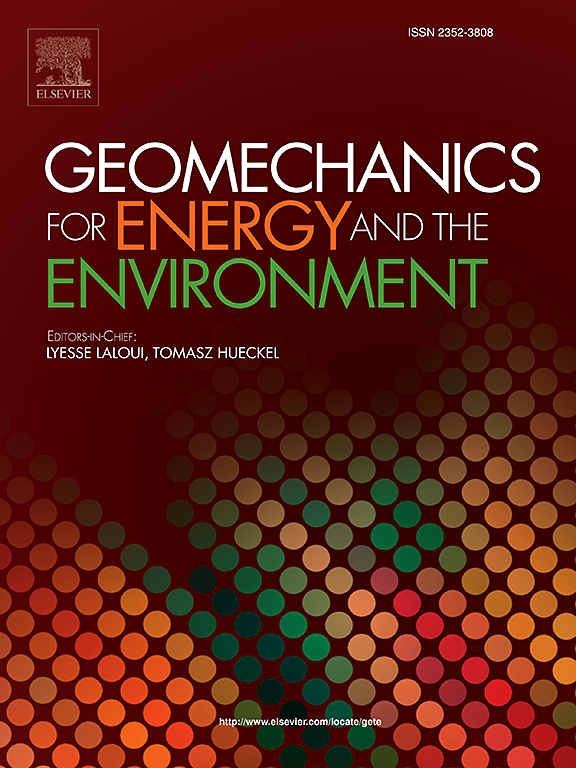Modeling gas migration through clay-based buffer material using coupled multiphase fluid flow and geomechanics with stress-dependent gas permeability
IF 3.3
2区 工程技术
Q3 ENERGY & FUELS
引用次数: 0
Abstract
A model for gas migration through clay-based buffer material is developed for modeling gas generation and migration associated with deep geologic nuclear waste disposal. The model is based on a multiphase fluid flow and geomechanics simulator that is adapted to consider enhanced gas flow when gas pressure is high enough to approach the confining stress magnitude. A key feature in the model is a direct coupling between gas permeability and stress, through a non-linear stress-dependent permeability function. The model was first tested and calibrated by modelling two different laboratory gas migration tests on Wyoming (MX-80) bentonite samples. The calibrated model was then applied to model gas migration through a bentonite buffer of a large-scale gas injection test (Lasgit) conducted at the Äspö Hard Rock Laboratory in Sweden. Observed preferential gas migration along interfaces (between compacted blocks and along the canister surface) required explicit representation of such interfaces in the model. The model with the stress-dependent gas permeability accurately captured observed experimental responses in terms of gas breakthrough time, peak gas pressure, and cumulative gas flow rates. The calibrated model was finally applied to simulate migration of hydrogen gas generated within a breached nuclear waste canister over 10,000 years, involving migration of much larger gas volumes. For the considered gas generation rate and host rock properties, the generated gas could migrate through the bentonite buffer and released into the surrounding host rock at a maximum gas pressure somewhat higher than the initial total stress, though a significant amount of hydrogen remained within the buffer. This modelling sets the stage for further detailed analysis of the impact of hydrogen gas generation on the long-term performance of nuclear waste repositories.
利用耦合多相流体流动和应力相关渗透率的地质力学模拟粘土基缓冲材料中的气体运移
为了模拟与深部地质核废料处置相关的气体生成和运移,建立了一个通过粘土基缓冲材料的气体运移模型。该模型基于多相流体流动和地质力学模拟器,当气体压力足够高,接近围应力值时,该模拟器可以考虑增强的气体流动。该模型的一个关键特征是渗透率和应力之间的直接耦合,通过非线性应力相关渗透率函数。首先,通过模拟怀俄明州(MX-80)膨润土样品的两种不同的实验室气体运移测试,对该模型进行了测试和校准。随后,在瑞典Äspö硬岩实验室进行的大规模注气试验(Lasgit)中,将校准后的模型应用于模拟气体通过膨润土缓冲层的运移。观察到沿界面(压实块之间和沿罐面)的优先气体迁移需要在模型中明确表示这种界面。具有应力相关渗透率的模型准确地捕获了气体突破时间、峰值气体压力和累积气体流速方面观察到的实验响应。校正后的模型最终被应用于模拟一个破裂的核废料罐中产生的氢气在10,000年以上的迁移,包括更大气体体积的迁移。考虑到气体的生成速率和宿主岩石的性质,生成的气体可以通过膨润土缓冲层运移,并在高于初始总应力的最大气体压力下释放到周围的宿主岩石中,但缓冲层中仍保留了大量的氢气。该模型为进一步详细分析氢气产生对核废料储存库长期性能的影响奠定了基础。
本文章由计算机程序翻译,如有差异,请以英文原文为准。
求助全文
约1分钟内获得全文
求助全文
来源期刊

Geomechanics for Energy and the Environment
Earth and Planetary Sciences-Geotechnical Engineering and Engineering Geology
CiteScore
5.90
自引率
11.80%
发文量
87
期刊介绍:
The aim of the Journal is to publish research results of the highest quality and of lasting importance on the subject of geomechanics, with the focus on applications to geological energy production and storage, and the interaction of soils and rocks with the natural and engineered environment. Special attention is given to concepts and developments of new energy geotechnologies that comprise intrinsic mechanisms protecting the environment against a potential engineering induced damage, hence warranting sustainable usage of energy resources.
The scope of the journal is broad, including fundamental concepts in geomechanics and mechanics of porous media, the experiments and analysis of novel phenomena and applications. Of special interest are issues resulting from coupling of particular physics, chemistry and biology of external forcings, as well as of pore fluid/gas and minerals to the solid mechanics of the medium skeleton and pore fluid mechanics. The multi-scale and inter-scale interactions between the phenomena and the behavior representations are also of particular interest. Contributions to general theoretical approach to these issues, but of potential reference to geomechanics in its context of energy and the environment are also most welcome.
 求助内容:
求助内容: 应助结果提醒方式:
应助结果提醒方式:


